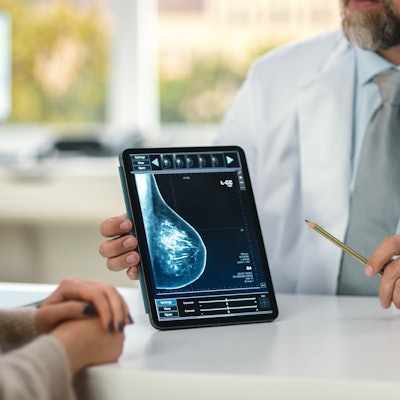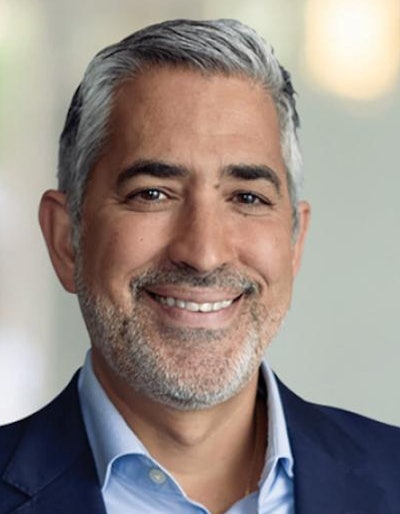
With emerging artificial intelligence (AI) technology, we will have the means to decrease false positives in breast cancer screening without an increase in breast cancer-related deaths.
 Dr. Alexander Sardiña, CEO of Whiterabbit.
Dr. Alexander Sardiña, CEO of Whiterabbit.Imagine mammography screening that is so advanced and accurate, it immediately delivers results to a significant percentage of women before they leave their appointment, providing the assurance and peace of mind of a clear mammogram. AI has the power to transform today's mammography technology, significantly decreasing the number of false positives.
Research suggests approximately half of women undergoing breast cancer screenings over the course of 10 exams may experience a false-positive result, and more than 20% may be subjected to unnecessary biopsies. These events lead to significant stress, unnecessary cost and time, and reduced screening compliance.
To reduce the number of false positives, the U.S. Preventive Services Task Force (USPSTF) has since 2009 recommended biennial mammography screening for women ages 50 to 74. Although the USPSTF recognizes mammography screenings in women 40 to 49 may reduce the risk of breast cancer deaths, it maintains the position that the number of false positives and unnecessary biopsies outweigh the potential benefit.
However, Mandelblatt et al has estimated that adoption of biennial guidelines in an effort to reduce false positives will lead to an increase in annual breast cancer-related deaths by as much as 30%. This is an important consideration when evaluating a change in guidelines in the U.S. Our guidelines must be broadly applicable to everyone but also encompass a strategy that can be meaningful for at-risk populations as well.
Although a moratorium is currently in place on the USPSTF recommendation, it ends on January 1, 2023. This is important, as recommendations by the USPSTF influence insurance coverage and payment, according to research by Mehrnoosh Soori, PhD, et al. If the USPSTF recommendations take effect, women under 50 could lose access to lifesaving mammography screenings covered by insurance.
Potential for AI
We imagine a future where AI technology can enable the U.S. to maintain annual mammography recommendations beginning at age 40 while significantly decreasing false positives.
For AI's power to be maximized, it must work in tandem with human intelligence. The radiologists' role is to find cancer, while the role of AI can be solely to identify normal mammography results. AI can be trained on massive datasets that include hundreds of thousands of mammograms, well beyond the scale of what a radiologist is capable of reviewing in a lifetime, examining every pixel in painstaking detail at its highest resolution and analyzing every potential finding based on its learning.
However, accuracy is not enough. AI could be tuned to an extremely high sensitivity so that it doesn't accidentally miss detectable cancer. It can assign a numeric threshold to findings from 0 to 100 that indicates the likelihood of cancer, yielding high sensitivity. This formula has the potential to transform the landscape of mammography by taking the human interpretation away from weighing a host of variables when making decisions about whether findings are suspicious or not.
According to research by Rodriquez-Ruiz et al (2019) and Dembrower et al (2020), there is a potential to eliminate 17%-60% of mammograms radiologists must read, as only those with a risk number above a defined threshold would be evaluated by a human. This workflow change would retain 99% and 80% sensitivity, respectively, depending on the threshold used. As a result, 17%-60% of women could leave their mammogram appointment with immediate results and peace of mind. Additionally, it could reduce callbacks due to false positives and noncancer biopsies.
This emerging technology is clinically significant as well. Once built, we believe AI has the potential to be cost-effective and reliable, enabling radiologists to spend more time diagnosing cancer and engaging with their patients. Additionally, it has the potential to better inform radiologists.
To date, most peer-reviewed publications make the assumption that the use of AI to rule out cancer does not impact radiologists' workflow. Whiterabbit is working on a retrospective study with the Stanford University School of Medicine to evaluate this long-standing assumption.
The study hypothesizes that today's emerging AI technology could influence radiologists and lead to an increased critical analysis of mammograms when radiologists know the cases they are reading have failed the AI's test for normal and that the detected findings have an increased potential to be cancerous. By applying AI, many of the challenges of today's computer-aided detection and diagnosis (CAD/CADx) applications can be overcome.
Before traditional CAD software was released on the market, developers evaluated approximately no more than a few hundred cancers in laboratory settings and did not include postmarket monitoring to assess the technology at scale over time. But today, new AI technology could be greatly enhanced by undergoing large-scale studies that test its capabilities on thousands of cancers across multiple institutions.
We believe once AI technology is deployed, performance metrics would provide radiologists with significant visibility into the application's functionality. They could then take this information into consideration while reviewing mammograms.
As the technology expands, there could also be an opportunity for site-specific autonomous AI -- the development of unique AI configurations that ensure the technology produces the same level of results submitted to the U.S. Food and Drug Administration (FDA) -- based on each facility's data and population. Accrediting facilities for autonomous AI could be a key function of the primary organizations focused on radiology.
To further expand monitoring metrics of AI technology, we envision a scenario in which customer data could be contributed to mammography databases. Although numerous state registries exist, participation is voluntary, which limits feedback to radiologists. Registry participation could help to identify cancer diagnoses that may have been missed.
With emerging AI technology, we have the opportunity to improve the interface of artificial and human intelligence while building a stronger, more transparent national healthcare system for all people.
Dr. Alexander Sardiña is a radiologist and CEO of Whiterabbit, a developer of AI-based software for breast cancer screening. He has two decades of experience in the healthcare industry. Before joining Whiterabbit, Sardiña served as the chief medical officer (CMO) for mammography services provider Solis Mammography. He has also been CEO and CMO of Covia Health, a Houston-based 3D mobile mammography provider.
Sardiña conducted most of his training in Houston at the Texas Medical Center and the University of Texas Health Science Center/MD Anderson Cancer Center while attending Baylor College of Medicine. He also obtained a radiology fellowship from Johns Hopkins Hospital.
The comments and observations expressed are those of the author and do not necessarily reflect the opinions of AuntMinnie.com.


















